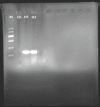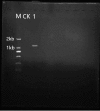Agrobacterium tumefaciens-mediated transformation of a hevein-like gene into asparagus leads to stem wilt resistance
- PMID: 31589638
- PMCID: PMC6779260
- DOI: 10.1371/journal.pone.0223331
Agrobacterium tumefaciens-mediated transformation of a hevein-like gene into asparagus leads to stem wilt resistance
Abstract
Asparagus stem wilt, is a significant and devastating disease, typically leading to extensive economic losses in the asparagus industry. To obtain transgenic plants resistant to stem wilt, the hevein-like gene, providing broad spectrum bacterial resistance was inserted into the asparagus genome through Agrobacterium tumefaciens-mediated transformation. The optimal genetic transformation system for asparagus was as follows: pre-culture of embryos for 2 days, inoculation using a bacterial titre of OD600 = 0.6, infection time 10 min and co-culturing for 4 days using an Acetosyringone concentration of 200 μmol/L. Highest transformation frequencies reached 21% and ten transgenic asparagus seedlings carrying the hevein-like gene were identified by polymerase chain reaction. Moreover, integration of the hevein-like gene in the T1 generation of transgenic plants was confirmed by southern blot hybridization. Analysis showed that resistance to stem wilt was enhanced significantly in the transgenic plants, in comparison to non- transgenic plants. The results provide additional data for genetic improvement and are of importance for the development of new disease-resistant asparagus varieties.
Conflict of interest statement
The authors have declared that no competing interests exist.
Figures













Similar articles
-
Generation and Screening of T-DNA Insertion Mutants Mediated by Agrobacterium tumefaciens in the Garden Asparagus Stem Blight Pathogen Phomopsis asparagi.Curr Microbiol. 2017 Nov;74(11):1270-1277. doi: 10.1007/s00284-017-1312-0. Epub 2017 Jul 20. Curr Microbiol. 2017. PMID: 28730458
-
Agrobacterium tumefaciens mediated transfer of Phaseolus vulgaris alpha-amylase inhibitor-1 gene into mungbean Vigna radiata (L.) Wilczek using bar as selectable marker.Plant Cell Rep. 2007 Feb;26(2):187-98. doi: 10.1007/s00299-006-0224-4. Epub 2006 Sep 16. Plant Cell Rep. 2007. PMID: 16983450
-
Transformation of tobacco and Arabidopsis plants with Stellaria media genes encoding novel hevein-like peptides increases their resistance to fungal pathogens.Transgenic Res. 2012 Apr;21(2):313-25. doi: 10.1007/s11248-011-9534-6. Epub 2011 Jun 25. Transgenic Res. 2012. PMID: 21706181
-
[T-DNA integration patterns in transgenic plants mediated by Agrobacterium tumefaciens].Yi Chuan. 2011 Dec;33(12):1327-34. doi: 10.3724/sp.j.1005.2011.01327. Yi Chuan. 2011. PMID: 22207378 Review. Chinese.
-
Sorghum (Sorghum bicolor L.).Methods Mol Biol. 2006;343:233-44. doi: 10.1385/1-59745-130-4:233. Methods Mol Biol. 2006. PMID: 16988348 Review.
Cited by
-
Agrobacterium tumefaciens-Mediated Transformation of the Aquatic Fungus Phialemonium inflatum FBCC-F1546.J Fungi (Basel). 2023 Dec 1;9(12):1158. doi: 10.3390/jof9121158. J Fungi (Basel). 2023. PMID: 38132759 Free PMC article.
-
Conquering Limitations: Exploring the Factors that Drive Successful Agrobacterium-Mediated Genetic Transformation of Recalcitrant Plant Species.Mol Biotechnol. 2025 Aug;67(8):3010-3026. doi: 10.1007/s12033-024-01247-x. Epub 2024 Aug 23. Mol Biotechnol. 2025. PMID: 39177863 Review.
-
Transcriptome-Wide Identification and Expression Analysis of Genes Encoding Defense-Related Peptides of Filipendula ulmaria in Response to Bipolaris sorokiniana Infection.J Fungi (Basel). 2024 Mar 28;10(4):258. doi: 10.3390/jof10040258. J Fungi (Basel). 2024. PMID: 38667929 Free PMC article.
References
-
- Anido FL, Cointry E. Asparagus In: Jaime P, Fernando N, editors. Vegetables II. Springer: Universidad Politécnica de Valencia; 2008. pp. 87–119.
-
- Chen HL, Xi JG, Gao JM, Zheng JL, Zhang SQ, Du YX,et al. Present situation and developing measure of Asparagus officinalis L. in the tropics. Guangdong Nong Ye Ke Xue 2013; 40(8):210–212.
Publication types
MeSH terms
Substances
LinkOut - more resources
Full Text Sources

